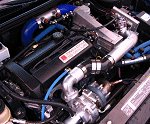

|
Street Class Unlimited Class
DOHC SOHC Ion Updated 1/05 For the most recent list of the fastest five cars click here. |
Beyond Bolt-Onsby: ChilangoOut of the box, the Saturn 1.9L engine, or the LLO, presents an excellent base to work with. At a hair under 2 liters of displacement, it provides a wide powerband with ample torque and good topend power. But what can been done to improve its performance? Everyone is familiar with the now standard Air, Intake, and Exhaust modifications, so I won't waste any time covering the basics. This article is geared towards Saturn enthusiasts who are looking for the next step, the step beyond bolt-ons. The three most common ways of making power gains are raising compression, increasing displacement, and increasing revs. Headwork is a category all its own, and we will cover that later. At any rate, it must be understood that the LLO is limited in a few aspects. There is little swing room inside the block for a stroker crank, and with its already longish 1.62:1 rod ratio, adding any more to the stroke would increase piston speeds and cylinder wall loading. And because of the rod ratio, increasing revs over the stock 6750 fuel cut off is not advised for the reasons previously mentioned. Here's why -
Above is a chart comparing peak piston speeds between an LLO and the venerable Honda B16. As you can see, the piston speeds are much higher for the LLO at every RPM point than the B16. The chart illustrates why the Honda B series of motors can sing along at high rpms. This is because the rod ratio is shorter. Shorter rod ratios produce lower pistons speeds and less cylinderwall loading. (In the automotive industry it is common to keep pistons speeds around 60 ft/sec in the interest of engine longevity) Now one can see why the engineers at Saturn put the rev limit and fuel cutoff where they did. At 8k, the LLO is running piston speeds that even aftermarket hardware would have trouble coping with, creating tensile loading approaching 1.5 tons. The stock Saturn engine wouldn't last long at such high rpms and failure almost always occurs during the exhaust stroke when the valves are open allowing the opportunity for bad things to happen. At the very least the big end of the rod will oval, spinning rod bearings, and at worst, tearing the rod in half and yanking the pin out of the piston pin bore. This tends to redesign the motor in a quick and brutal fashion. So short of destroking the LLO and major headwork, increasing revs isn't really a realistic option. So what is a determined Saturn tuner to do? HeadworkThe stock LLO cylinderhead is pretty good out of the box. The lost foam casting method used by Saturn tends to limit unfavorable core shift and parting lines in the ports. "Over square" motors like the LLO respond more to intake velocity more than intake volume so, hogging out the ports is counterproductive. Just mild port work is sufficient. For those on a bigger budget, deshroading the intake valves and installing blended narrow 1-2mm valve seats is a good idea. The factory valves come with a 3-angle grind, and any additional work is a waste of time. Aside from seatwork, major bowl work isn't necessary. Just a minor blending will work fine. The jury is still out on installing oversize valves, as its benefits haven't been proven on a dyno. Like a lot of things, bigger isn't always better, and big numbers on a flowbench doesn't always translate into the real world. The stock valves are more than sufficient, as are the springs and retainers. With a stock PCM one cannot run lots of compression or revs, so the stock spring/seat pressures are fine. Headwork for FI is slightly different, and requires SS valves, tool steel valve seats, and a few other things we won't get into here. Increase CompressionThe static compression ratio for the LLO is 9.5:1. Raising the static compression increases thermal dynamic efficiency, and thus increases power. Increasing compression can be done 2 ways: Milling the head, or using aftermarket pistons. The head can be milled to increase compression by as much as a full point, but it is not recommended, due to slack in the timing chain. Milling the head will also retard cam timing, which on a LLO is not a good idea. (The SOHC motor, however, responds quite nicely to retarded cam timing) The preferred way to increase compression is through the use of aftermarket pistons. On pump gas, the maximum safe compression that LLO can run and not detonate itself to pieces is around 11:1. 10.5:1 is a safe bet, and will tolerate the occasional bad tank of gas. In additional to the increase in compression, you can also order oversize pistons to get a nice bump in displacement. Going too big will weaken the cylinder bores to the point where aftermarket sleeves will be required. Going with a 83mm piston will bump displacement up around 2.0 liters and still keeps things safe. Also, talk to the aftermarket company that is making your pistons. They will make it exactly how you want it. Be specific. The standard off the shelf stuff I've seen from a certain major piston vendor, for example, were far too heavy for NA applications and too generic in design. Remember that the piston is the bottom of the combustion chamber, and its importance in power production cannot be understated. And, in a NA motor, every gram saved in rotating mass means more power. Reduce weight where you can, and the easiest way to do it is with the pistons. Ross Pistons, for example, will lighten their standard pistons as much as possible, if you request it. The units in my own car are forged, much stronger, and weigh considerably less than OEM pistons. Light is good. As for the rods, the stock rods are more than sufficient for NA use. The post '99 fracture rods are particularly nice. They are longer that earlier years, so if you want to use them, make sure that your aftermarket pistons allow for the longer length. However, if one plans to run NOS, aftermarket rods would be a wise investment. What about aftermarket camshafts?Camshafts are another way to increase power, but like with a lot of common mods, the factory PCM limits their potential. Camshafts increase power by adding additional lift and duration, and this has an adverse effect on the amount of vacuum generated at any given crank angle and engine speed. This is important to understand, as the Saturn PCM uses a MAP sensor that has a lot of control over fuel delivery. At idle, there is vacuum and this slowly goes away to zero as the engine approaches WOT. One of the byproducts of a 'hot' cam is the tell tale lumpy idle. This is caused by the reduced level of vacuum at idle. The Saturn PCM interprets this as 'WOT' and dumps fuel accordingly, regardless of the throttle position. This causes the car to stall, stutter, and die. This PCM quirk effectively limits any camshaft's potential. The only known aftermarket cam that seem to work is offered by JG Engine Dynamics, and since they 'work', they are very mild indeed. Too mild, in my opinion, to be worth their asking price. Set GoalsFinally, know what it is you want. It's a pretty simple question, but it's a question that many people forget to ask themselves. It's hard to meet performance goals if you don't know what it is you want to achieve. By defining your performance goals, you can accurately design and build to meet those goals. Too many times have I seen enthusiasts throw a bunch of cool parts together, only to be disappointed with the results. So you must ask yourself. Is the car a street machine? Street/Strip? All out race? All motor? Is NOS of forced induction in the future? These questions must be addressed before any wrench is turned. |
|
||||||||||||||||||||||||



